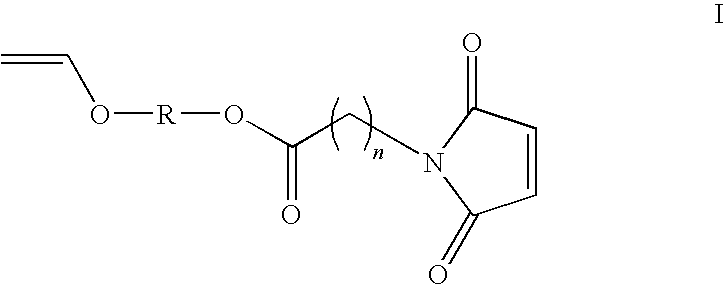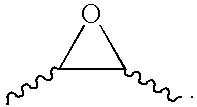Hetero-functional compounds and methods for use thereof
a technology of heterofunctional compounds and compounds, applied in the field of thermosetting compositions, can solve the problems of thermomechanical expansion mismatch, small solder joints, and demand for smaller and more powerful electronic components
- Summary
- Abstract
- Description
- Claims
- Application Information
AI Technical Summary
Benefits of technology
Problems solved by technology
Method used
Image
Examples
example 1
Synthesis of 4-Acryloxybutylvinyl Ether
[0159]A 125 milliliter single-neck flask was charged with 11.6 grams (100 millimole) 4-hydroxybutylvinyl ether, 15.4 grams (150 millimoles) triethylamine, and twenty milliliters tetrahydrofuran. This solution was stirred magnetically and cooled in an ice bath. A solution of 9.05 grams (105 millimoles) acryloyl chloride dissolved in 20 milliliters THF was then dripped in over the course of forty-five minutes. The mix was stirred another hour while the temperature was allowed to rise to room temperature. The THF and excess triethylamine were removed on the rotoary evaporator. The residue was extracted with three 20 ml portions of toluene and the toluene phase was rinsed with 20 ml deionized water. The toluene phase was dried with ten grams anhydrous magnesium sulfate and the toluene was removed to yield a mobile yellow liquid. The product weighed 12.3 grams (72% of theory). This liquid had major IR absorptions at 1723, 1635, 1616, 1408, 1188, 959...
example 2
Synthesis of Cyclohexane Dimethanol Mono-Methacrylate Mono-Vinyl Ether
[0160]A 500-ml round-bottomed flask equipped with a Teflon-coated magnetic stir bar and reflux condenser was charged with 34.0 g (200 mmol) of cyclohexane dimethanol mono-vinyl ether, followed by the addition of 34.0 g (220 mmol) of methacrylic anhydride. To the flask was added 150 g of hexane, and 20.2 g (200 mmol) of triethylamine. The solution was refluxed for 3 hours to complete the reaction. After cooling the amine salt was vacuum filtered. The clear solution was washed in a separatory funnel with 2×50 ml of water, followed by 1×50 ml of saturated sodium chloride solution. The solution was then dried over anhydrous sodium sulfate, and gravity filtered. The solvent was removed using a rotary evaporator, and 43.0 g (90.3% yield) of a low viscosity yellow liquid was obtained. The FTIR spectrum of the sample showed major bands at 2924, 1719, 1637, 1612, 1321, 1166, and 811 wavenumbers.
example 3
Ethylene Glycol Mono-Maleimidoundecanoate Mono-Vinyl Ether
[0161]A 500-ml round bottomed flask equipped with a Teflon-coated magnetic stir-bar and a reflux condenser was charged with 19.0 g of ethylene glycol mono-maleimidoundecanoate (54.1 mmol), followed by the addition of a large excess of butyl-vinyl ether 250.0 g (2.5 mol). To the flask was also added 0.1 g of palladium acetate phenanthroline complex, and the solution was stirred at 60° C. for 14 hours. The excess butyl vinyl ether was completely removed using a rotary evaporator, and 100 g of toluene was added to the flask. The solution was flash filtered through 10 g of silica gel to remove the catalyst and unreacted starting material. The toluene was then removed using a rotary evaporator. Approximately 15 g of a yellow liquid was obtained, which solidified upon standing overnight. The FTIR of the sample showed major bands at 2924, 1735, 1664, 1619, 1172, 827, and 695.
PUM
| Property | Measurement | Unit |
|---|---|---|
| Time | aaaaa | aaaaa |
| Composition | aaaaa | aaaaa |
| Adhesivity | aaaaa | aaaaa |
Abstract
Description
Claims
Application Information
 Login to View More
Login to View More - R&D
- Intellectual Property
- Life Sciences
- Materials
- Tech Scout
- Unparalleled Data Quality
- Higher Quality Content
- 60% Fewer Hallucinations
Browse by: Latest US Patents, China's latest patents, Technical Efficacy Thesaurus, Application Domain, Technology Topic, Popular Technical Reports.
© 2025 PatSnap. All rights reserved.Legal|Privacy policy|Modern Slavery Act Transparency Statement|Sitemap|About US| Contact US: help@patsnap.com



